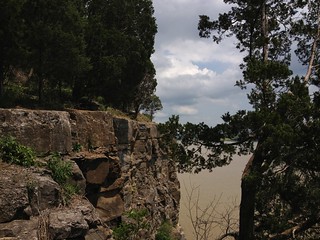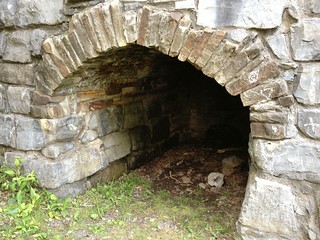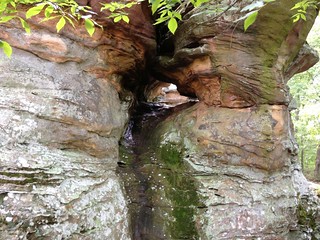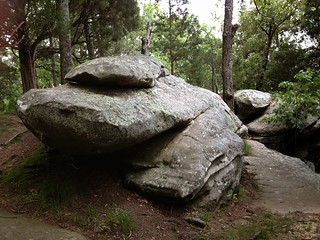Shawnee National Forest/Cache River road trip: Day 7
May 24, 2013
Today was the day. We were going to the place that had inspired my interest in Shawnee and southernmost Illinois — the Cache River. Home to bald cypress, tupelo, and buttonbush, the Cache is the conjunction of north and south, east and west. Years ago I’d seen photos of the Cache taken by reptile keeper whose passion was photography and wanted to see what he’d seen. I may never make it to the Great Swamp (the Okefenokee) brought so vividly to life by author Marjorie Zapf, but here was my chance to experience something a little like, but now within my reach.
When the Ohio River adopted its present course, it left the Cache River to meander across rich and vast wetlands. Among the outstanding natural features found within the area today are massive cypress trees whose flared bases, called buttresses, exceed 40 feet circumference. Many are more than 1,000 years old, including one that has earned the title of state champion bald cypress because of its huge trunk girth, towering height and heavily branched canopy . . . the Cache River Valley contains four distinct ecological regions. Its hodgepodge of ecological factors has resulted in a collage of natural communities, each with its own unique assemblage of physical attributes, plants and animals.
Illinois Department of Natural Resources
How could a place like that not be a lot more magical than anything conceived by Disney?
First, though, it was time to fuel in Hidden Lake Bed and Breakfast’s spacious breakfast room, which overlooks prettily landscaped grounds (although not the lake, because Hidden Lake really is hidden from the house) and a variety of bird feeders that attracted a variety of birds — flickers, indigo buntings, finches, hummingbirds, and even a hopeful hawk. Mary Jo, a former CFO, loves to cook, and it shows — three breakfast courses, all amazing. I’m so fond of that kind of comfort that I could have sat in that room for hours, just enjoying coffee and bird watching. We did linger for a while, but the Cache kept calling.
It may have called, but it didn’t tell me how to find it. I wasn’t thinking, and I didn’t spend the time to figure out what and where the best access points were. That’s how we ended up at Snakehole in the Little Black Slough Hunting Area, where hunters can sign in and out. As you can see, it was a perfect day and the area was amazing, but it didn’t fit my mental picture of a bald cypress-tupelo ecosystem. It turns out Google Maps just sent us to what was probably the closest access point to the Cache River State Natural Area. After walking around and seeing the sights, we headed down Old Cypress Road and got lost and lost again until we finally found our way out of the maze of scenic country roads.
It turns out our first stop should have been the Cache River Wetlands Center further south. Here you can get all kinds of information and souvenirs, then take a walk along a couple of trails. The Tunnel Hill State Trail is a great way to see the sights from a bicycle, while pedestrians have a choice of trails along and over the water. I’ve never seen so many fish in a river before, many of them needle-nosed gar. I suspect that this part of the Cache is a fisherman’s dream. Again, it was a gorgeous place, and I could have stayed there the rest of the day if pain allowed, but it still didn’t quite look like what I had expected. We decided to seek out the state champion bald cypress, indicated on the map we’d picked up.
On the way out, J. was distracted by a flock of snowy egrets across the road, and we went back and forth a few times while he tried to get a good photo or two.
Next, we found the area where you can view the state champion bald cypress, although at first we couldn’t tell which way to go. Most of the few people returning to the parking lot on the one path didn’t seem to know what we were talking about. We decided to go that way and see what happened.
Not far down (close enough for me and my fading energy), we found a viewing platform and a sign pointing to the state champ. We spent at least an hour taking photos, admiring the knees of the bald cypresses, and debating exactly which tree the sign was indicating — depending on your angle to the sign, the arrow seemed to indicate a few different trees, none of them the twin of the pictured tree. By the end, we thought we had it pinned down, and it turns out that we were right.
While standing on the viewing deck facing the water, the champion bald cypress (Taxodium distichum) can be seen slightly to the left (about 11 o’clock). This tree stands 73 feet tall, has a trunk circumference at 4.5 feet height from river bottom of 34 feet 3 inches, and boasts a crown spread of 35 feet. The Citizens Committee to Save the Cache and Jack White submitted these measurements to the Illinois Department of Natural Resources, Division of Forest Resources in th early 1990’s. Only native Illinois trees are considered for a Big Tree designation. Points are assigned based on a tree’s measurements: one point for each inch in circumference; one point for each foot in height; and, one point for one-fourth the crown spread. This tree earned a score of 492.75, and was recognized as the State Champion Bald Cypress in 1992.
Illinois Department of Natural Resources fact sheet
We wanted to see some of the 10 other state champion trees in the Cache River area, especially the water tupelo and cherrybark, but for some reason I had one of my rare bad days as a navigator and couldn’t seem to find my way anywhere. On the plus side, we’d finally found an abundance of bald cypress. On the down side, I now realize we really should have made an effort to find Heron Pond, where you can immerse yourself in the Cache.
We did do the next best thing, however. While at the Wetlands Center, we’d found out that guided and self-guided canoe trips on the Lower Cache were available and decided that was an option. (When I talked to the owner and told him I would have trouble getting into and out of a canoe, he said we would “manage it”). To me, the rate for a two-hour guided tour seemed reasonable — how can you put a price on such a great experience? By the next day, we’d decided definitely to do it.
We passed the Wetlands Center on the way back so J. could again try to take more photos of the snowy egrets. This time, we noticed many dead and dying turtles on the road near the center. I’d seen a sign earlier that warned this was their season to be on the move. Poor critters never knew what hit them . . .
And so back to town to do laundry and to dine at El Jalapeño in Anna. And then back to the B&B to find a note from the housekeeper saying she’d been in and a second note from Mary Jo saying she’d left something in the refrigerator — which turned out to be chocolate-covered strawberries. Mmmm.

























































































































